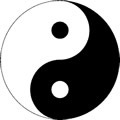Tai Chi for Flexibility,
Balance and Health
Tai chi, or by its full name Tai chi chuan, is well known to Westerners for its slow motion routines that groups of people practice in parks all around the world. Mostly, the soft movements are practiced regularly for good health and longevity. However, less well known in the West are the martial applications and competitions.

In fact, the Mandarin term “t’ai chi ch’uan” translates to “supreme ultimate fist,” “boundless fist,” or “great extremes boxing.” The concept of “supreme ultimate” appears in both Taoist and Confucian Chinese philosophy and represents the fusion of Yin (receptive) and Yang (active) into a single ultimate represented by the familiar Taijitu symbol (shown here).
Tai chi is generally classified as a "soft" or “internal” branch of traditional Chinese martial arts. The training first and foremost requires learning solo routines known as forms. The forms are typified by their very slow movements. However, many styles of the art have secondary forms that go at a faster pace. Some traditional schools teach partner exercises known as pushing hands and martial applications of a form’s movements.
For our purpose here, which is senior fitness, the focus is on practice of the forms for their health benefits. Seniors are not alone in this focus. Worldwide, many practitioners of varying ages have little or no interest in martial training. They view the forms as a kind moving meditation that brings about calmness, physical flexibility and balance.
Health Benefits
Before its introduction to Western students, the health benefits were largely explained through the lens of traditional Chinese medicine. However, today some well known practitioner/teachers have encouraged Western scientific testing and studies to prove its value and gain even further recognition and acceptance in the West.
So far, studies have shown favorable effects on flexibility, balance control, cholesterol levels, cardiovascular and respiratory function, and other health criteria. The quality of some of the studies, however, has been called into question. Maybe it is too soon to draw too many conclusions based on the studies made to date.
What we do know is that there are millions of practitioners, and the majority of the health studies that have been done have indicated tangible benefits.
History and Styles
There are five major styles, each named after the Chinese family that originated it. They are, in the order of verifiable age . . .
1. Chen style
2. Yang style
3. Wu or Wu/Hao style of Wu Yu-hsiang
4. Wu style of Wu Ch’uan-yu and Wu Chien-ch’uan
5. Sun style
Their order in popularity (numbers of practitioners) is Yang, Wu, Chen, Sun, and Wu/Hao. The five share a lot in underlying theory, but vary in their approach to training. There are also new styles and hybrids that are offshoots of the five family schools.
Contemporary Tai Chi
Classes have become popular in hospitals, clinics, and community centers (as well as public parks) during the last 30 years or so. The art’s reputation for reducing stress and its benefits to physical and mental health make it one of the fastest growing fitness and health activities in the United States. Aging Baby Boomers, wanting to remain healthy and active, may be a part of this growth.
Further Reading
• “Tai Chi Boosts Immunity, Improves Physical Health in Seniors" (2003). Acupuncture Today.
Return from Tai Chi to the Flexibility Exercises page.
Enjoy this page? Please pay it forward. Here's how . . .
Would you prefer to share this page with others by linking to it?
- Click on the HTML link code below.
- Copy and paste it, adding a note of your own, into your blog, a Web page, forums, a blog comment,
your Facebook account, or anywhere that someone would find this page valuable.